科普版英语三年级下册教案(全册)
- 格式:doc
- 大小:167.00 KB
- 文档页数:80

总课时: 1教学笔记课题: Lesson 1 Back to school教学内容:1.Let ’s talk的前两个情景2.生词 again, bad教学目标:1.能听懂,会说,会认,会拼读bad,at,help,me,hi2.听懂会说,并用来对话,交际用语Glad to see you. Metoo.How are you? Not bad.教学重点:1.词汇2.交际用语教学方法:采用自问自答,和听音乐跟说的方法。
教具准备:录音机教学过程:一.复习检查:A.复习见面问候:师生问好:“Hi!XXX”生:“Hi!Miss(Mr)X”师:“Glad to meet you.”生:“Glad to meet you, too.”师:“How are you?”生:“I’m ok. Thank you. And you?”师:“I’m fine, too.”B: 复习单词:am, can, and, that, thank, glad .二.导入新课:A.学习生词again和bad。
先在黑板上写词。
读几遍。
然后老师“Look!I can clap my hands”同时拍一下手,再说:“I canclap my hands again”。
让学生明白词的意思。
再说:‘I’m fine。
How are you?” “Not bad”。
B:导入对话:用听音导入法和自问自答导入法,导入Let’ s talk的前两个情景:先听两遍录音,然后老师先自问自答:“Glad to meet youa gain”“Glad to meet you,too”。
再说:“Glad to meet youagain。
”“Me too”让学生猜一猜“Me too”的意思,然后再通过自问自答将对话表演一遍,学生听懂后再听两遍。
三.操练:1.听音跟说,逐句跟说,集体复述。
2.对话两人之间,或学生分成左右两部分,各担任一个角色,互换角色,同座之间,等多种方法进行。
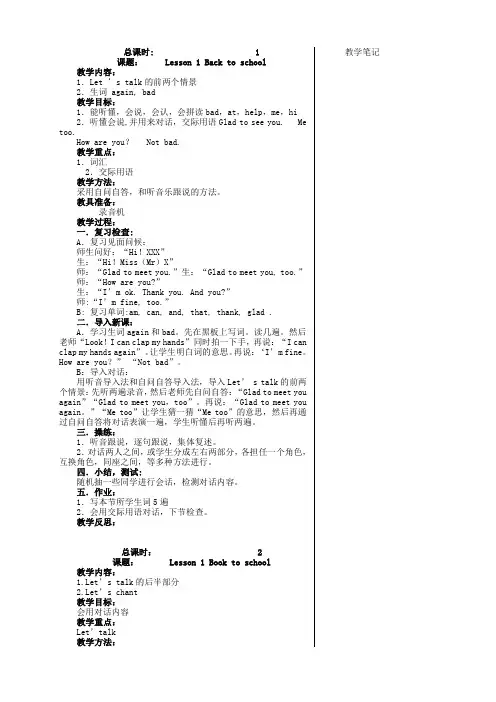
总课时: 1教学笔记课题: Lesson 1 Back to school教学内容:1.Let ’s talk的前两个情景2.生词 again, bad教学目标:1.能听懂,会说,会认,会拼读bad,at,help,me,hi2.听懂会说,并用来对话,交际用语Glad to see you. Metoo.How are you? Not bad.教学重点:1.词汇2.交际用语教学方法:采用自问自答,和听音乐跟说的方法。
教具准备:录音机教学过程:一.复习检查:A.复习见面问候:师生问好:“Hi!XXX”生:“Hi!Miss(Mr)X”师:“Glad to meet you.”生:“Glad to meet you, too.”师:“How are you?”生:“I’m ok. Thank you. And you?”师:“I’m fine, too.”B: 复习单词:am, can, and, that, thank, glad .二.导入新课:A.学习生词again和bad。
先在黑板上写词。
读几遍。
然后老师“Look!I can clap my hands”同时拍一下手,再说:“I canclap my hands again”。
让学生明白词的意思。
再说:‘I’m fine。
How are you?” “Not bad”。
B:导入对话:用听音导入法和自问自答导入法,导入Let’ s talk的前两个情景:先听两遍录音,然后老师先自问自答:“Glad to meet youa gain”“Glad to meet you,too”。
再说:“Glad to meet youagain。
”“Me too”让学生猜一猜“Me too”的意思,然后再通过自问自答将对话表演一遍,学生听懂后再听两遍。
三.操练:1.听音跟说,逐句跟说,集体复述。
2.对话两人之间,或学生分成左右两部分,各担任一个角色,互换角色,同座之间,等多种方法进行。
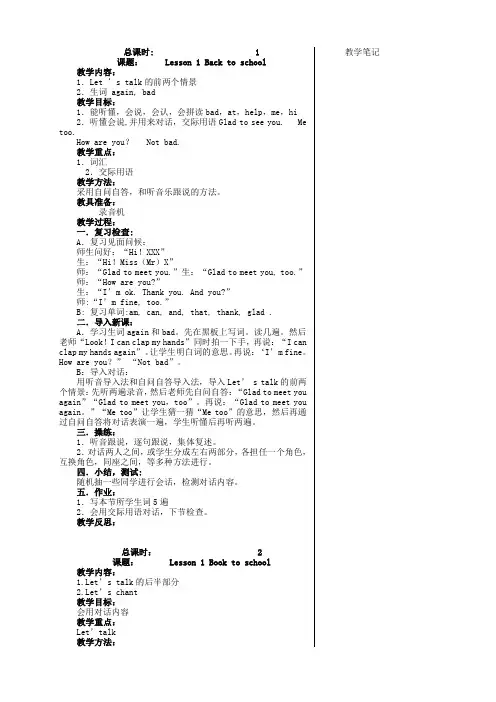
总课时: 1教学笔记课题: Lesson 1 Back to school教学内容:1.Let ’s talk的前两个情景2.生词 again, bad教学目标:1.能听懂,会说,会认,会拼读bad,at,help,me,hi2.听懂会说,并用来对话,交际用语Glad to see you. Metoo.How are you? Not bad.教学重点:1.词汇2.交际用语教学方法:采用自问自答,和听音乐跟说的方法。
教具准备:录音机教学过程:一.复习检查:A.复习见面问候:师生问好:“Hi!XXX”生:“Hi!Miss(Mr)X”师:“Glad to meet you.”生:“Glad to meet you, too.”师:“How are you?”生:“I’m ok. Thank you. And you?”师:“I’m fine, too.”B: 复习单词:am, can, and, that, thank, glad .二.导入新课:A.学习生词again和bad。
先在黑板上写词。
读几遍。
然后老师“Look!I can clap my hands”同时拍一下手,再说:“I canclap my hands again”。
让学生明白词的意思。
再说:‘I’m fine。
How are you?” “Not bad”。
B:导入对话:用听音导入法和自问自答导入法,导入Let’ s talk的前两个情景:先听两遍录音,然后老师先自问自答:“Glad to meet youa gain”“Glad to meet you,too”。
再说:“Glad to meet youagain。
”“Me too”让学生猜一猜“Me too”的意思,然后再通过自问自答将对话表演一遍,学生听懂后再听两遍。
三.操练:1.听音跟说,逐句跟说,集体复述。
2.对话两人之间,或学生分成左右两部分,各担任一个角色,互换角色,同座之间,等多种方法进行。
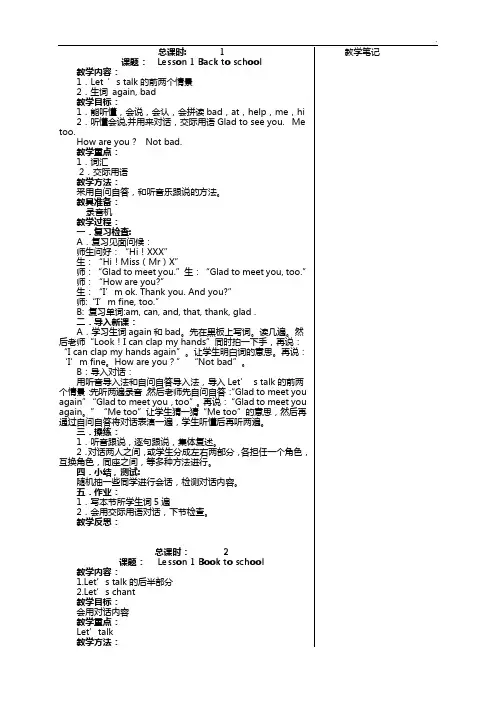
总课时: 1教学笔记课题:Lesson 1 Back to school教学内容:1.Let ’s talk的前两个情景2.生词again, bad教学目标:1.能听懂,会说,会认,会拼读bad,at,help,me,hi2.听懂会说,并用来对话,交际用语Glad to see you. Metoo.How are you?Not bad.教学重点:1.词汇2.交际用语教学方法:采用自问自答,和听音乐跟说的方法。
教具准备:录音机教学过程:一.复习检查:A.复习见面问候:师生问好:“Hi!XXX”生:“Hi!Miss(Mr)X”师:“Glad to meet you.”生:“Glad to meet you, too.”师:“How are you?”生:“I’m ok. Thank you. And you?”师:“I’m fine, too.”B: 复习单词:am, can, and, that, thank, glad .二.导入新课:A.学习生词again和bad。
先在黑板上写词。
读几遍。
然后老师“Look!I can clap my hands”同时拍一下手,再说:“I can clap my hands again”。
让学生明白词的意思。
再说:‘I’m fine。
How are you?”“Not bad”。
B:导入对话:用听音导入法和自问自答导入法,导入Let’s talk的前两个情景:先听两遍录音,然后老师先自问自答:“Glad to meet youagain”“Glad to meet you,too”。
再说:“Glad to meet youagain。
”“Me too”让学生猜一猜“Me too”的意思,然后再通过自问自答将对话表演一遍,学生听懂后再听两遍。
三.操练:1.听音跟说,逐句跟说,集体复述。
2.对话两人之间,或学生分成左右两部分,各担任一个角色,互换角色,同座之间,等多种方法进行。
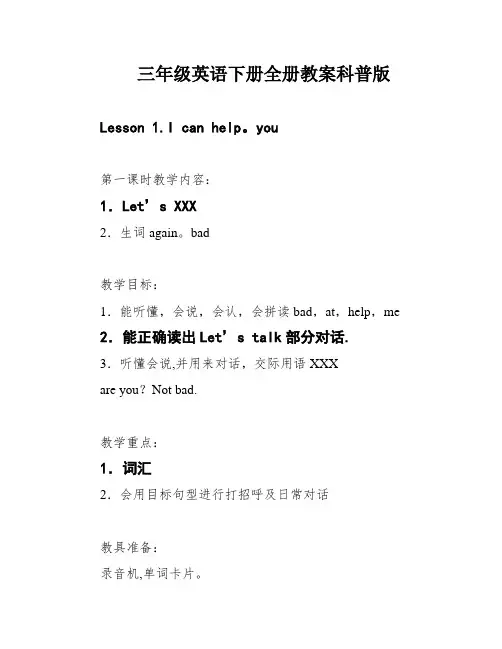
三年级英语下册全册教案科普版Lesson 1.I can help。
you第一课时教学内容:1.Let’s XXX2.生词again。
bad教学目标:1.能听懂,会说,会认,会拼读bad,at,help,me 2.能正确读出Let’s talk部分对话.3.听懂会说,并用来对话,交际用语XXXare you?Not bad.教学重点:1.词汇2.会用目标句型进行打招呼及日常对话教具准备:录音机,单词卡片。
教学过程:一.引学:A.复见面问候:师生问好:“Hi!XXX”生:“Hi!Miss(Mr)X”师:“Nice to meet you.”生:“Nice to meet you。
too.”师:“How are you?”生:“I’m ok。
Thank you。
And you?”师:“I’m fine。
too.”B:温单词: help。
me。
English。
glad。
二.引探新课:A:研究生词again和bad。
先在黑板上写词。
读几遍。
然后老师“Look!I can clap my hands”同时拍一下手,再说:“I can clapXXX”。
让学生认识打听词的意义。
再说:‘I’mfine。
Howareyou?”“Not bad”。
B:导入对话:用听音导入法和自问自答导入法,导入Let’stalk的前两个情景:先听两遍录音,然后老师先自问自答:“Glad to meet youagain”“Glad to meet you,too”。
再说:“XXX。
”“Metoo”让学生猜一猜“Metoo”的意思,然后再通过自问自答将对话表演一遍,学生听懂后再听两遍。
C:用同样的方式研究第三个情景,研究句型:“I am XXX.”“I can help you.”三.引导操演:1.听音跟说,逐句跟说,集体复述。
2.对话两人之间,或学生分红左右两局部,各担负一个角色,交换角色,同座之间,等多种办法举行。
四.小结,测试:随机抽一些同学举行会话,检测对话内容。
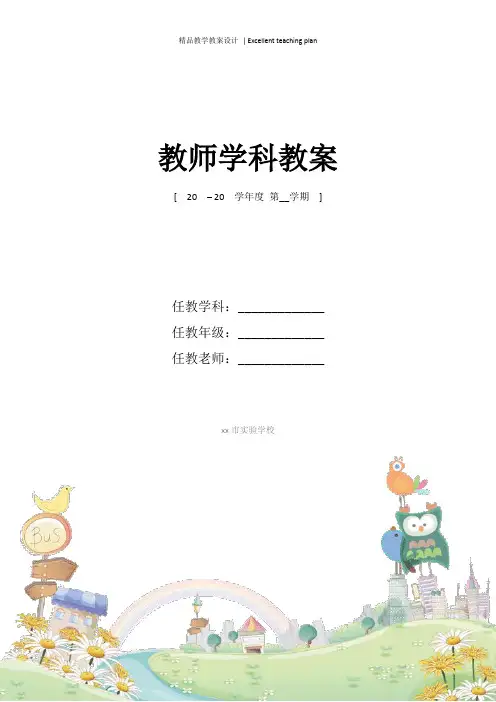
教师学科教案[ 20 – 20 学年度第__学期]任教学科:_____________任教年级:_____________任教老师:_____________xx市实验学校总课时: 1课题: Lesson 1 Back to school教学内容:1.Let ’s talk的前两个情景2.生词 again, bad教学目标:1.能听懂,会说,会认,会拼读bad,at,help,me,hi2.听懂会说,并用来对话,交际用语Glad to see you. Me too.How are you? Not bad.教学重点:1.词汇2.交际用语教学方法:采用自问自答,和听音乐跟说的方法。
教具准备:录音机教学过程:一.复习检查:A.复习见面问候:师生问好:“Hi!XXX”生:“Hi!Miss(Mr)X”师:“Glad to meet you.”生:“Glad to meet you, too.”师:“How are you?”生:“I’m ok. Thank you. And you?”师:“I’m fine, too.”B: 复习单词:am, can, and, that, thank, glad .二.导入新课:A.学习生词again和bad。
先在黑板上写词。
读几遍。
然后老师“Look!I can clap my hands”同时拍一下手,再说:“I can clap my hands again”。
让学生明白词的意思。
再说:‘I’m fine。
How are you?” “Not bad”。
B:导入对话:用听音导入法和自问自答导入法,导入Let’ s talk的前两个情景:先听两遍录音,然后老师先自问自答:“Glad to meet you again”“Glad to meet you,too”。
再说:“Glad to meet you again。
”“Me too”让学生猜一猜“Me too”的意思,然后再通过自问自答将对话表演一遍,学生听懂后再听两遍。
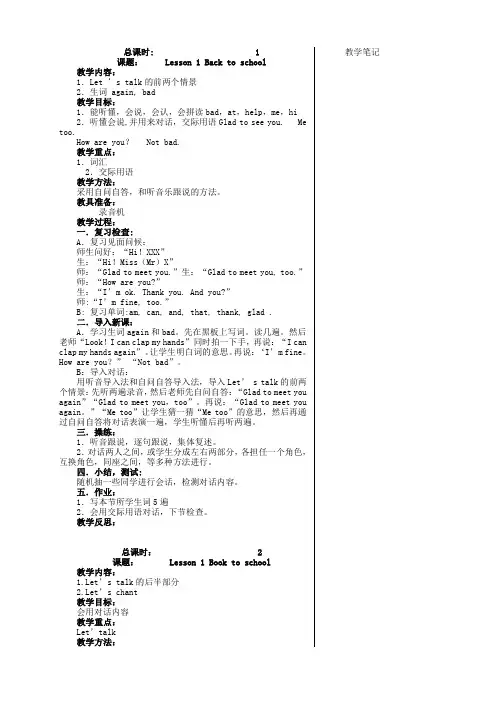
总课时: 1教学笔记课题: Lesson 1 Back to school教学内容:1.Let ’s talk的前两个情景2.生词 again, bad教学目标:1.能听懂,会说,会认,会拼读bad,at,help,me,hi2.听懂会说,并用来对话,交际用语Glad to see you. Metoo.How are you? Not bad.教学重点:1.词汇2.交际用语教学方法:采用自问自答,和听音乐跟说的方法。
教具准备:录音机教学过程:一.复习检查:A.复习见面问候:师生问好:“Hi!XXX”生:“Hi!Miss(Mr)X”师:“Glad to meet you.”生:“Glad to meet you, too.”师:“How are you?”生:“I’m ok. Thank you. And you?”师:“I’m fine, too.”B: 复习单词:am, can, and, that, thank, glad .二.导入新课:A.学习生词again和bad。
先在黑板上写词。
读几遍。
然后老师“Look!I can clap my hands”同时拍一下手,再说:“I canclap my hands again”。
让学生明白词的意思。
再说:‘I’m fine。
How are you?” “Not bad”。
B:导入对话:用听音导入法和自问自答导入法,导入Let’ s talk的前两个情景:先听两遍录音,然后老师先自问自答:“Glad to meet youa gain”“Glad to meet you,too”。
再说:“Glad to meet youagain。
”“Me too”让学生猜一猜“Me too”的意思,然后再通过自问自答将对话表演一遍,学生听懂后再听两遍。
三.操练:1.听音跟说,逐句跟说,集体复述。
2.对话两人之间,或学生分成左右两部分,各担任一个角色,互换角色,同座之间,等多种方法进行。
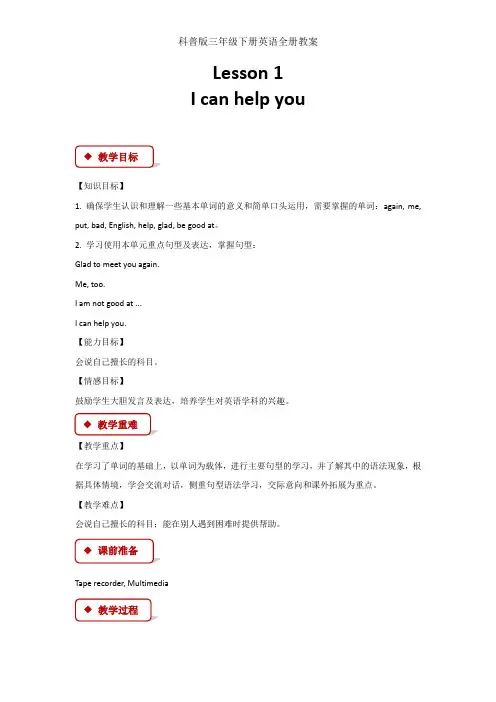
Lesson 1I can help you◆教学目标【知识目标】1. 确保学生认识和理解一些基本单词的意义和简单口头运用,需要掌握的单词:again, me, put, bad, English, help, glad, be good at。
2. 学习使用本单元重点句型及表达,掌握句型:Glad to meet you again.Me, too.I am not good at ...I can help you.【能力目标】会说自己擅长的科目。
【情感目标】鼓励学生大胆发言及表达,培养学生对英语学科的兴趣。
◆教学重难【教学重点】在学习了单词的基础上,以单词为载体,进行主要句型的学习,并了解其中的语法现象,根据具体情境,学会交流对话,侧重句型语法学习,交际意向和课外拓展为重点。
【教学难点】会说自己擅长的科目;能在别人遇到困难时提供帮助。
◆课前准备◆Tape recorder, Multimedia◆教学过程Step 1 Let’s talk1. 导人对话:本部分对话分成三部分导入,课件出示每部分示图及对话。
教师播放录音,先将全段放一遍,然后逐句放,让学生逐句跟读并译成中文。
(1) 第一部分对话为:-- Hello, Miss Li! Glad to meet you again.-- Me, too.(2) 第二部分对话为:-- Hi, Eve! How are you?-- I’m OK, thank you, and you?-- Not bad, thanks.(3) 第三部分对话为:-- I’m not good at English.-- I can help you.-- Thank you.-- That’s OK.2. 操练:(1) 学生听录音并逐句跟读两遍。
(2) 同桌间充当不同角色进行对话。
(3) 选三组学生,每组两人,分角色表演对话。
Step 2 Let’s learn1. 导入主题句:I am not good at ...I can help you.2. 教师课件出示主题句对话,然后指图示范对话,说过几遍后略作解释,说明be good at意为“擅长……”,用来表示某人可以在某件事上做得好。
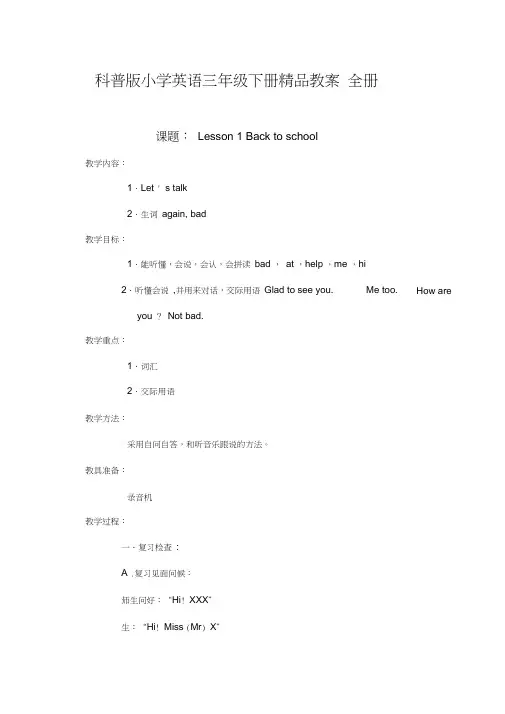
科普版小学英语三年级下册精品教案全册课题:Lesson 1 Back to school教学内容:1.Let ' s talk2.生词again, bad教学目标:1.能听懂,会说,会认,会拼读bad ,at ,help ,me ,hi2.听懂会说,并用来对话,交际用语Glad to see you. Me too.How are you ?Not bad.教学重点:1.词汇2.交际用语教学方法:采用自问自答,和听音乐跟说的方法。
教具准备:录音机教学过程:一.复习检查:A .复习见面问候:师生问好:“Hi! XXX”生:“Hi! Miss (Mr) X”师“Glad to meet you. ”生:“Glad to meet you, too. ”:师“How are you? 。
:生:“I' m ok. Thank you. And you? 。
师:“ I'm fine, too.B: 复习单词:am, can, and, that, thank, glad .二.导入新课:A .学习生词again 和bad 。
先在黑板上写词。
读几遍。
然后老师“ Look !I can clap my hands ”同时拍一下手,再说:“ I can clapmy hands aga in ”。
让学生明白词的意思。
再说:’I'm fine。
How are you ?' “Not bad ”。
B:导入对话:用听音导入法和自问自答导入法,导入Let' s talk 的前两个情景:先听两遍录音,然后老师先自问自答:“Glad to meet youagain ” “Glad to meet you , too ”。
再说:“Glad to meet you again 。
‘“ Me too 。
让学生猜一猜“ Metoo 。
的意思,然后再通过自问自答将对话表演一遍,学生听懂后再听两遍。
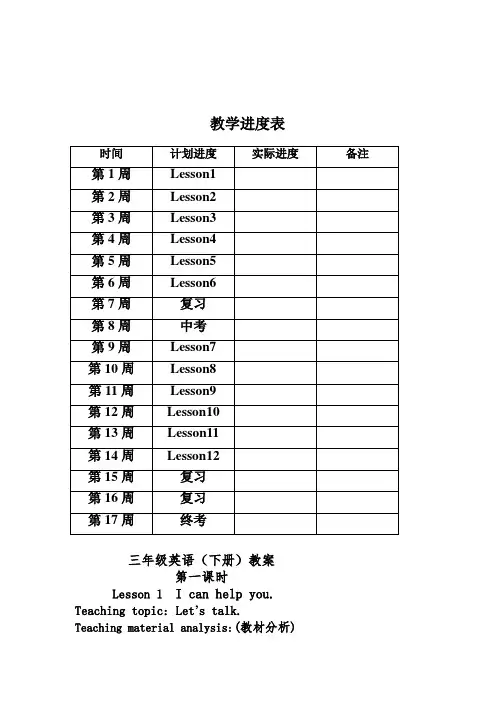
教学进度表三年级英语(下册)教案第一课时Lesson 1 I can help you. Teaching topic: Let’s talk.Teaching material analysis:(教材分析)1)The students can listen, say, read and write some words correctly:again me bad English help gladMe , too. be good at在……方面做的好2)The students can master the pattern: I’m not good at English.Goal request:(教学目的)The students can master the pattern: I’m not good at English.Key difficulty:(重点难点)How to read and write the words:again me bad English help be not good atTeaching times:(教学时间)1Teaching metheds:(教学方法)three doubts three searches Teaching aid study:(教学工具)cards, tapeTeaching process:(教学过程)Step1设疑自探 (5 minutes)1.Write the new words on the blackboard.again me hi bad at English help glad, Me , too be good at在……方面做的好T:Please look at the blackboard and talk about how topronounce the words correctly.2.Listen to the tape carefully then answer my question.T:Can you tell me the meaning of the text?Ss:Sorry,we do not knowT:Now ,please talk about the meaning of the text from one to four, OK?Ss: OKStep 2解疑合探 (15 minutes)1.Then encourage the Ss to stand up and read the words,if all the Ss do not know how to read, the teacher should tell them.2.The teacher choose some Ss to stand up and explain it.If there is something wrong,the teacher should correct it.3.The teacher read the text. Then let Ss read after the teacher.4.Then let the Ss read the dialogue by themselves,after that choose one or two teams to stand up and act it out .S1:Glad to see you again. S2: Me ,too.S1: Hello, Tom ! How are you? S2:I’m OK.Thank you.And you?S1: Not bad. S2: I’m not good at English.S1:I can help you. S2:Thank you.S1:That’s OK.Step 3质疑再探 (10minutes)T:Can you tell me something about the text?S1:What is the meaning of the sentence“Me too.”?S2:What is the meaning of the sentence“Not bad.”?S3: What is the difference between“Not bad.”and “I’m fine,too.”?……Step4 运用拓展 (10minutes)练习:英汉连线我(宾格)再,又帮助英语在……坏的again help English bad meBb writing desgin:(板书设计)Lesson 1 I can help you.again mebad English helpbe not good at在……方面不太好Me, too. 我也是很高兴。
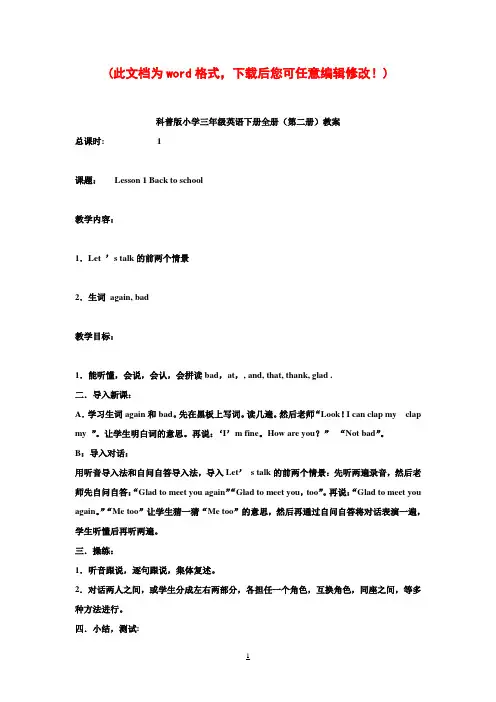
(此文档为word格式,下载后您可任意编辑修改!)科普版小学三年级英语下册全册(第二册)教案总课时: 1课题:Lesson 1 Back to school教学内容:1.Let ’s talk的前两个情景2.生词again, bad教学目标:1.能听懂,会说,会认,会拼读bad,at,, and, that, thank, glad .二.导入新课:A.学习生词again和bad。
先在黑板上写词。
读几遍。
然后老师“Look!I can clap my clap my ”。
让学生明白词的意思。
再说:‘I’m fine。
How are you?”“Not bad”。
B:导入对话:用听音导入法和自问自答导入法,导入Let’s talk的前两个情景:先听两遍录音,然后老师先自问自答:“Glad to meet you again”“Glad to meet you,too”。
再说:“Glad to meet you again。
”“Me too”让学生猜一猜“Me too”的意思,然后再通过自问自答将对话表演一遍,学生听懂后再听两遍。
三.操练:1.听音跟说,逐句跟说,集体复述。
2.对话两人之间,或学生分成左右两部分,各担任一个角色,互换角色,同座之间,等多种方法进行。
四.小结,测试:随机抽一些同学进行会话,检测对话内容。
五.作业:1.写本节所学生词5遍2.会用交际用语对话,下节检查。
教学反思:总课时: 2课题:Lesson 1 Book to school教学内容:1.Let’s talk的后半部分2.Let’s chant教学目标:会用对话内容教学重点:Let’talk教学方法:采用自问自答法教具准备:录音机卡片教学过程:一.复习检查:A.上节所学句子,师举卡片,上面写“很高兴见到你。
”“我也是。
”“你好吗?”“不错。
”等。
让学生说英文。
B.三分钟自由对话:若干同学站起来,说上一课时及以前所学内容。
二.导入新课:A.生词和词组,English, at, not good at, 1 Book to school教学内容:1.20个辅音字母。
总课时: 1教学笔记课题: Lesson 1 Back to school教学内容:1.Let ’s talk的前两个情景2.生词 again, bad教学目标:1.能听懂,会说,会认,会拼读bad,at,help,me,hi2.听懂会说,并用来对话,交际用语Glad to see you. Metoo.How are you? Not bad.教学重点:1.词汇2.交际用语教学方法:采用自问自答,和听音乐跟说的方法。
教具准备:录音机教学过程:一.复习检查:A.复习见面问候:师生问好:“Hi!XXX”生:“Hi!Miss(Mr)X”师:“Glad to meet you.”生:“Glad to meet you, too.”师:“How are you?”生:“I’m ok. Thank you. And you?”师:“I’m fine, too.”B: 复习单词:am, can, and, that, thank, glad .二.导入新课:A.学习生词again和bad。
先在黑板上写词。
读几遍。
然后老师“Look!I can clap my hands”同时拍一下手,再说:“I canclap my hands again”。
让学生明白词的意思。
再说:‘I’m fine。
How are you?” “Not bad”。
B:导入对话:用听音导入法和自问自答导入法,导入Let’ s talk的前两个情景:先听两遍录音,然后老师先自问自答:“Glad to meet youa gain”“Glad to meet you,too”。
再说:“Glad to meet youagain。
”“Me too”让学生猜一猜“Me too”的意思,然后再通过自问自答将对话表演一遍,学生听懂后再听两遍。
三.操练:1.听音跟说,逐句跟说,集体复述。
2.对话两人之间,或学生分成左右两部分,各担任一个角色,互换角色,同座之间,等多种方法进行。
Is that a pig?教案教学建议(Suggested teaching methods)1. 课时安排:本课教学内容可安排4个课时。
第一课时Let's talk的前两个情景第二课时Let's talk的剩余部分和Let's chant第三课时Let's learn和Let's sing第四课时Let's read和Let's make2. 各课时教学内容和步骤第一课时Let's talk的前两个情景(1)复习检查:A. 复习单词:复习已学过的含e短音[e]的单词。
教师举dress, red等单词的卡片,让学生拼读并说出中文。
或者教师读英文,让学生拼写出来并写出中文意思。
B. 三分钟自由对话:叫若干对同座的同学站起来,用以前学过的对话内容自由对话。
(2)导入新课:A. 学习生词:先出示on和ship两个单词的卡片,让学生拼读,并用简笔画介绍它们的词义。
接着学so, many, animal和elephant 等4个词,教师出示挂图,逐个指其中的动物说:“It's an animal.”“It's an animal, too.”等,然后指所有的动物说:“many animals”和“so many animals”,再指大象说:“It's an elephant.”在教以上单词的同时,在黑板上板书这些单词,或出示单词卡片。
教到elephant 一词时,提一下字母组合ph读作[f]。
在以上单词全部教完后,教师逐个领读,读几遍后让学生先说英文,再说中文。
先让全体学生一起说,再叫个别学生站起来说。
B. 导入对话:用图片导入法导入。
教师出示挂图(或画简笔画),并让学生听两遍录音,边听边将关键词写在图边上:nice / So / Look, pig / isn't, elephant。
听完录音后,教师手拿一幅“ship”的画,充当东东说:“How nice on a ship!”接着充当汤姆,指着挂图中的许多动物说:“Wow! So many animals.”再充当齐齐,指着大象说:“Look!A big pig.”再充当伊芙说:“No, it isn't a pig. It's an elephant.”表演两遍后,让学生听两遍录音。